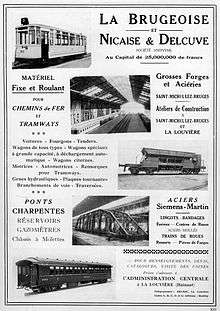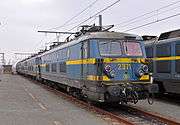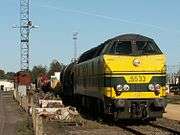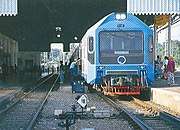La Brugeoise et Nivelles
La Brugeoise et Nivelles SA, later BN Constructions Ferroviaires et Métalliques (abbrev. BN), was a Belgian manufacturer of railway locomotives and other rolling stock; it was formed by a merger of two companies: La Brugeoise et Nicaise et Delcuve and Les Ateliers Métallurgiques de Nivelles.
 | |
| Industry | Rail vehicles |
|---|---|
| Predecessor | La Brugeoise, Nicaise et Delcuve, Les Ateliers Métallurgiques de Nivelles |
| Successor | after 1977 BN Constructions Ferroviaires et Métalliques after 1988 Bombardier Transportation Belgium |
| Headquarters | Bruges , Belgium |
The company was acquired by Bombardier Inc. in 1988, plants in Nivelles and Manage closed in 1989 and 2000; as of 2011, the plant located in Bruges operated as Bombardier Transportation Belgium S.A..
History


In 1851, Joseph De Jaegher founded a hardware store in the Burg in Bruges; in 1855, this expanded with a steel workshop on the Raamstraat, named Ateliers J. Jaegher; in 1891, this merged with another steel making company in the nearby Gieterijstraat, the Usines Ferdinand Feldhaus, to form the Ateliers de Construction Forges et Aceries de Bruges. By 1900, the company was a major Belgian metal engineering company. In 1905, the company moved its plant and offices to a larger site with good railway connections close to the Ghent Ostend canal at Sint-Michiels in Bruges. Until 1913, the company operated as the Société Anonyme La Brugeoise,[1][2] abbreviated as "La Brugeoise".[3]
In 1913, the company La Brugeoise et Nicaise et Delcuve was formed by the merger of the Bruges-based companies La Brugeoise and Nicaise et Delcuve during a re-organisation of the interests of the holding company Trust Métallurgique Belge-Français,[4] and capitalised at 10 million francs; the new company included a modern steel works, forge and mills at Sint-Michiels.[4]
During World War I, the facilities were occupied by German forces, and at the end of the war had been substantially damaged,[1] however post war construction also required the organisation products. In 1919, control of the company was taken by the Société Générale de Belgique.[1][5]
In 1956, this merged with Les Ateliers Métallurgiques de Nivelles to form La Brugeoise et Nivelles. In 1977, the company merged with Constructions Ferroviaries du Centre (CFC) (in Familleureux, Hainaut, Belgium) to form BN Constructions Ferroviaries et Métalliques (BN).[6]
In 1986, Bombardier took at 45% share in BN, which was increased to 90.6% in 1988.[7] The plants at Bruges and Manage became the BN division of Bombardier Eurorail in 1991.[8][9]
The factory in Nivelles closed and was demolished in 1989/90.[10]
In 2000, Bombardier announced it was to close the subsidiary plant BN Manage based in Manage, Belgium; the action attracted criticism from both trade unions and the Belgian government; perception was that Bombardier had used the 'jobs card' to win a Belgian double deck train contract worth 8.5 billion Belgian francs. The closure announcement came as a complete volte-face from Bombardier's previous statements which included optimistic statements about the Manage plant's future.[11] Train-making ended at the site which was re-purposed by Duferco for steel plate processing.[12]
As of 2011, the factory in Bruges was part of Bombardier Transportation as Bombardier Transportation Belgium S.A..[13]
Products
In 1875, the Manage plant produced its first rail vehicles; in 1885, the Bruges plant produced its first tram.[3] Much of the early output prior to that was freight wagons.[1] In addition to railway rolling stock, the company also manufactured bridges, locks and sluice gates, cranes, and vessels for the chemical and sugar industries.[1]
In 1961, the company acquired a license (from Anglo-Franco-Belge) to manufacture GM-EMD locomotives for the European market.[14][note 1] In 1973, factories in Bruges and Familleureux produced the company's first underground trains, for the STIB.[3]
BN produced 26 veículos Leves sobre trilhos (VLT) light rail cars for use on Line 2 of the Rio de Janeiro Metro, which were later converted to full metro cars. Eight cars (delivered 1979) were built in Belgium and the remaining 18 (delivered 1980 and 1982) by Cobrasma SA in their plant in São Paulo.[15] Some of the ones built by Cobrasma were briefly used by the Campinas Light Rail system.
The original "Type 1" cars for Portland, Oregon's MAX Light Rail system, ordered in 1981, were built by BN in association with Bombardier Inc.. They were assembled in North America using bodyshells sourced in La Pocatiere, Canada.[16][17]
In 1989, a consortium of BN, ANF Industrie and Bombardier won the order for the construction of the passenger Eurotunnel Shuttle wagons,[18] valued at 36 billion francs, of which BN's contribution was valued at 8 billion.[19]
In 1994, the company, in association with INKA and Holec, built commuter trains for the KRL Jabotabek system.
In 1998, after takeover by Bombardier, the company obtained an order with a total value of 22.2 billion Belgian francs to produce 78 Bombardier Voyager class trains for the railways in the United Kingdom at the Bruges and Manage plants; BN's value share of the contract was estimated at 8 to 10 billion Belgian francs.[20] Deliveries took place in the early 2000s.[21][6] Also as part of Bombardier, the company also produced Flexity Outlook and Flexity Swift vehicles for Brussels and Rotterdam respectively, the bodyshells of the Autorail à grande capacité for the SNCF, and B09 vehicles for the Docklands Light Railway.[6] Finally, the company continues to supply the Belgian Railways (NMBS/SNCB) with passenger rail vehicles.[6]
 "La Brugeoise" metro-tram for Argentina, 1913
"La Brugeoise" metro-tram for Argentina, 1913 NMBS/SNCB class 23, built 1955–7
NMBS/SNCB class 23, built 1955–7 NMBS/SNCB class 55, built 1961–62 (EMD license)
NMBS/SNCB class 55, built 1961–62 (EMD license) NMBS/SNCB class 26, built 1964–71
NMBS/SNCB class 26, built 1964–71 Kusttram (Belgium) rolling stock, built 1980–83
Kusttram (Belgium) rolling stock, built 1980–83 NMBS/SNCB class 27, built 1981–84
NMBS/SNCB class 27, built 1981–84_-_Portland%2C_Oregon.jpg) Portland MAX Type 1 LRV (Bombardier j.v.), built 1983-6
Portland MAX Type 1 LRV (Bombardier j.v.), built 1983-6 LRV for Amsterdam Metro, built 1990–94
LRV for Amsterdam Metro, built 1990–94 BN-Holec Electric Train (Indonesia), Built 1994-2001
BN-Holec Electric Train (Indonesia), Built 1994-2001 UK class 220, built 2000–2001 (Bombardier)
UK class 220, built 2000–2001 (Bombardier)
See also
- Ateliers de Constructions Electriques de Charleroi (ACEC), manufacturer of electrical equipment for BN-built locomotives
- Ateliers de Construction du Nord de la France (ANF), rolling stock manufacturer in northern France, part of Bombardier Transportation
- La Brugeoise cars (Buenos Aires Underground)
Notes
- These included the SNCB class 55, class 62 and CFL 1800.
References
- Sources
"No. 16 : Vaartdijkstraat 5-7, BN (Bombardier-Eurorail), de electriciteitscentrale". Open Monumentendag Vlaanderen (PDF). www.bruge.be (in Dutch). Stad Brugge. 1997. pp. 70–73 (37–8 in pdf).
"No.22 : Vaartdijkstraat 5-7 : BN, Divisie van Bombardier-Eurorail". Open Monumentendag Vlaanderen (PDF). www.brugge.be (in Dutch). Stad Brugge. 1994. pp. 55–57 (29–30 in pdf). - "Staalconstructiebedrijf "La Brugeoise & Nivelles" (ID: 77882)". inventaris.vioe.be (in Dutch). Vlaams Instituut voor het Onroerend Erfgoed (www.vioe.be). Retrieved 1 July 2011.
- Francoise Zonemberg; Marc Charlet; Philippe De Bock; Sylvain Piraux (31 March 2000). "Manage face à la mort de l'usine du groupe canadien SALE TEMPS POUR LES BOMBARDIER L'avenir fracassé des ouvriers de Manage confrontés au néant A la "BN" de Bruges, la vie continue (presque) comme avant La saga "Brugeoise et Nivelles"". archives.lesoir.be. Le Soir.
- Marie-Thérèse Bitsch (1994). La Belgique entre la France et l'Allemagne, 1905-1914 (in French). Publications de la Sorbonne. pp. 232–3.
- Jo Cottenier; Patrick de Boosere; Thomas Gounet (1989). La Société générale: 1822-1992. Editions Aden. p. 83.
- "Bombardier: Bruges, Belgium" (PDF). www.bombardier.com. Bombardier Transportation. Archived from the original (PDF) on 13 December 2010.
- "Bombardier Transportation - A Global Transportation Leader" (PDF). Japan Railway & Transport Review (42). December 2005. Archived from the original (PDF) on 13 June 2011. Retrieved 29 June 2011.
- Miville Tremblay (1994). Le sang jaune de Bombardier: la gestion de Laurent Beaudoin (in French). PUQ. p. 56.
- "LE GROUPE CANADIEN BOMBARDIER REGROUPE EN BELGIQUE SES FILIALES EUROPEENNES. LA BN SE TRANSFORME EN BOMBARDIER EURORAIL". archives.lesoir.be (in French). Le Soir. 14 May 1991.
- Jean Vandendries (5 October 1989). "LE DEMANTELEMENT DU SITE DE LA BN PREPARE LE NIVELLES DE L'AN 2000". archives.lesoir.be (in French). Le Soir.
- Catherine Delbar; Jurgen Oste (28 April 2000). "Bombardier announces intention to close Manage plant". www.eurofound.europa.eu. European Industrial Relations Observatory on-line.
- Claire Bortolin (15 February 2001). "Exit Bombardier, voici Manage Steel Center" (in French).
- "Bombardier Transportation in Belgium". www.bombardier.com. Bombardier. Retrieved 28 June 2011.
- Diesel railway traction, 15, Railway Gazette, 1961, p. 418
- http://www.tramz.com/br/lr/r.html
- Mass Transit, 8, 1981, p. 178
- Pacific Rail News, 1986, p. 135
- Peter Semmens; Yves Machefert-Tassin (1995). "13. Passenger-vehicle shuttle fleet". In Colin J. Kirkland (ed.). Engineering the Channel Tunnel. Taylor & Francis. p. 191.
- Beatrice Delvaux; Marc Charlet (18 August 1989). "LA RESURRECTION DE L'EX-BRUGEOISE ET NIVELLES TECHNIQUE ET SECURITE... LE PILOTE QUI A MENE BN AU BOUT DU TUNNEL GROUPE BN". archives.lesoir.be (in French). Le Soir.
- Francoise Zonemberg (10 December 1998). "Bruges et Manage fabriqueront les trains d'outre-Manche Commande de Virgin à Bombardier". archives.lesoir.be (in French). Le Soir.
- Sources:
Dave Coxon. "Class 221 testing and operations". www.traintesting.com. Archived from the original on 17 May 2011.
Dave Coxon. "Class 220 testing and operations". www.traintesting.com. Archived from the original on 17 May 2011.
External links
- 51.192376°N 3.232059°E, Former 'La Brugeoise' factory gatehouse, protected historic building
- 51.191071°N 3.229275°E, Bombardier Transportation Belgium S.A. factory location
| Wikimedia Commons has media related to La Brugeoise et Nivelles SA. |